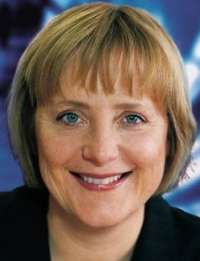Merkel opens much-anticipated exhibition on German history
Chancellor Angela Merkel on Friday opened a much-anticipated exhibition on 2,000 years of German history, which she said could help the reunited country move beyond its "divided memory" of the past. The new permanent display opens to the public Saturday at the German Historical Museum in a building that was once home to communist East Germany 's ideologically tinted "Museum for German History."

The exhibition "does not force upon us a rigid picture of history," Merkel, the first leader of reunified Germany to have grown up in the east, said at the opening ceremony. "It instead invites people to reflect ... that certainly cannot be taken for granted," she added. "I still remember well how, in the former East Germany , whole generations of students were shepherded through museums that tried to give them a Marxist view of history."
The new exhibition features more than 8,000 artifacts covering 7,500 square meters (more than 80,000 square feet) including Adolf Hitler's globe, a hat that Napoleon wore at the Battle of Waterloo, rare theological manuscripts and a Lucas Cranach portrait of Martin Luther. Some of the oldest exhibits are bones and a Roman helmet from the site of a 9 A.D. battle in which Germanic tribes ambushed and destroyed three Roman legions a common marker of the nation's birth, although Germany was not united until the 19th century.
It takes visitors right through to the 1990 reunification of post-World War II Germany and after, featuring a torn-down section of the Berlin Wall. Friday's inauguration was attended by a key figure in the merger of east and west former Chancellor Helmut Kohl, the museum's initiator.
Merkel noted that westerners and easterners often have different memories of recent history, and that the museum had to encompass the experiences of both. "In this way, the divided memory of the Germans can be made into a common one," Merkel said. "Achieving that would be a great result for this exhibition."
In addressing the Holocaust, the exhibit focuses on a haunting cutaway model of the gas chambers and crematoria at the Auschwitz-Birkenau death camp. Small figures are shown walking in, undressing, being gassed, then being shoveled into the ovens which curators say is meant to make the killing of 6 million more tangible by presenting its victims as individuals.
"Only in the acceptance of the constant responsibility for the most terrible phase of German history is there the chance for us Germans to shape the future," Merkel said. "Only in this way, after the Nazi tyranny and out of the rubble of World War II, could the attempt succeed to bring about a free and democratic state in Germany and fill it with life", reports the AP.
N.U.
Subscribe to Pravda.Ru Telegram channel, Facebook, RSS!


